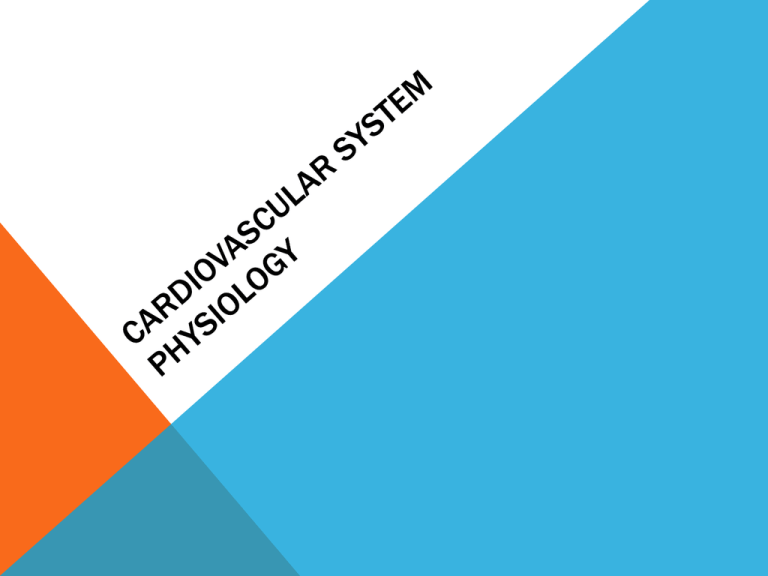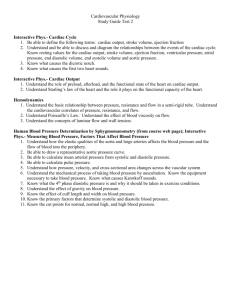Document 14231969
advertisement

HEART ACTIONS • A cardiac cycle is a complete heartbeat • During a cardiac cycle, the pressure in the heart chambers rises and falls • These pressure changes open and close the valves • The first part of a heart sound (lub) occurs when the AV valves are closing • The second part of a heart sound (dub) occurs when the semilunar valves are closing CARDIAC CONDUCTION SYSTEM • The heart is autorhythmic, able to contract itself without nervous or hormonal stimulation • Components include: SA node, AV node, and specialized cardiac muscle tissue and cells • These components coordinate the events of the cardiac cycle (heartbeat) • SA node – located in the right atrium near the opening of the superior vena cava; initiates one impulse after another (pacemaker) • The impulse spreads to other areas of the myocardium due to cardiac muscle cells and gap junctions • AV node – located in the inferior part of the right atrium • The impulse passes from the AV node to the AV bundle (group of fibers) and the Purkinje fibers carry the impulse to distant regions of the myocardium ELECTROCARDIOGRAM • Recording of the electrical changes in the myocardium during a cardiac cycle • Electrodes are placed on the skin and connected to wires that respond to weak electrical changes • When the SA node triggers a cardiac impulse, the atrial fibers depolarize, producing an electrical change = P wave • When the cardiac impulse reaches the ventricular fibers, they rapidly depolarize producing an electrical change = QRS complex • The electrical changes that accompany ventricular muscle fiber repolarization slowly produce a T wave, ending the ECG pattern • Physicians use ECG patterns to assess the hearts ability to conduct impulses BLOOD PRESSURE • The force the blood exerts against the inner walls of the blood vessels • The maximum pressure achieved during ventricular contraction is called the systolic pressure • When the ventricles relax, the arterial pressure drops, and the lowest pressure that remains in the arteries before the next ventricular contraction is called the diastolic pressure • A sphygmomanometer measures blood pressure • The cuff is wrapped around the arm so that is surrounds the brachial artery; air is pumped into the cuff until the cuff pressure exceeds the pressure in that artery squeezing the vessel closed and stopping its blood flow; as air is slowly released from the cuff, the air pressure inside it decreases; when the cuff pressure is just slightly lower than the systolic blood pressure in the brachial artery, the artery opens for a small volume of blood to spurt through, producing a sharp sound heard through the stethoscope (systolic pressure); as the cuff pressure continues to drop, louder sounds are heard; when the cuff pressure is just slightly lower than that within the fully opened artery, the sounds disappear (diastolic pressure) • Normal blood pressure is 120/80 CARDIAC OUTPUT • For the body to function properly, the heart needs to pump blood at a sufficient rate to maintain an adequate and continuous supply of oxygen and other nutrients to the brain and other vital organs • Cardiac output = describes the amount of blood your heart pumps each minute • A healthy heart pumps about 5-6 liters of blood every minute when a person is resting CARDIAC OUTPUT Cardiac Output: It is determined by: 1. The amount of blood pumped by the left ventricle during each beat (stroke volume) 2. The number of heart beats per minute The amount of blood ejected by a ventricle during each contraction (single beat) is called stroke volume Cardiac output is an indication of the blood flow through peripheral tissues; without adequate blood flow, homeostasis cannot be maintained; helps keep blood pressure at the levels needed to supply oxygen-rich blood to your organs CARDIAC OUTPUT For an adult at rest… Stroke volume = 80 mL (average) Heart rate = 75 beats per minute (average) Therefore, Cardiac Output (CO) = Stroke Volume x Beats per Minute CO = 80 mL/beat x 75bpm CO = 6000mL/min (6L/min)






